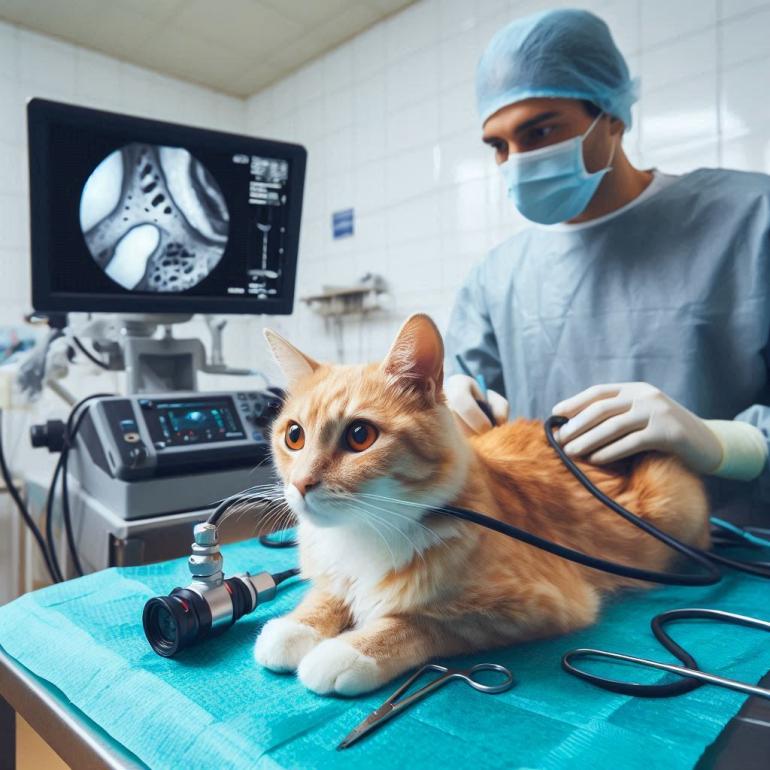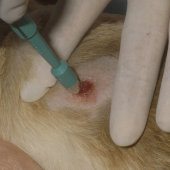Laparoscopic ovariectomy (keyhole spay)

Laparoscopic ovariectomy (keyhole spay)
A laparoscopic ovariectomy, also referred to as a "keyhole" spay, is a minimally invasive procedure that involves making a tiny abdominal incision in order to remove the ovaries and uterus. By doing this, the big cut that is needed to remove the womb and eggs during a normal neutering is not made. Because it doesn't involve a big cut, the procedure generally causes less pain and discomfort during recovery than open surgery. It also lets people get back to regular exercise faster.

Why should I get my cat spayed?
People usually spay or neuter their cats to stop them from having litters and making too many cats. Some other benefits are lowering the chance of breast cancer and avoiding uterine infections that could be fatal. It's also helpful to stay away from messy and difficult seasons like "heat." If your pet has certain health problems, your vet may suggest that you have them spayed or neutered. This is because some diseases, like diabetes, are easier to control in spayed animals.
Even though your pet's behavior won't change after surgery, some bad behaviors that are caused by hormones, like violence, "humping" (mounting inanimate objects), and a stronger sense of territory, may get better. Before you decide to spay or neuter your pet to help with behavior problems, you should talk to your vet about it in detail. If your cat has learned to do these things, spaying won't fix the problem by itself. You'll need to talk to a professional in behavior.
What changes might I see in my cat after spaying?
The changes that were seen after neutering will stay the same no matter how the treatment was done.
Pets that have been spayed or neutered may gain weight. To avoid this, you might need to stop giving your pet 10% to 15% more food every day. Plus, you should make sure your pet does as much as they did before the treatment.
Even though the risk is small generally, females who have been neutered are more likely to have accidents. Some pet owners say that the coat isn't as good after getting it spayed. These stories are based on anecdotes because there is no published scientific proof to support them.
When should I get my pet spayed?
Cats can be spayed at any time after they have finished their excessive vocalization or meowing, and they go through their season every three weeks. Early spaying could be required to avoid unforeseen litters, depending on the cause for spaying, such as having an outside cat or a male in the house.
Why should I choose a key hole surgery over a routine spay?
There has been a lot of laparoscopic ovariectomy on dogs for about thirty years now. At first, it was only available at specialized clinics, but more and more regular veterinary practices are starting to give it. Not only is it faster than traditional neutering, but the smaller cuts cause less tissue damage, which means your cat will likely heal faster and have less pain after surgery. Because the cuts are smaller, your pet is also less likely to want to lick them and pull out the stitches. The day after surgery, most pets go back to doing things that are pretty normal for them.
How do I prepare my pet before surgery?
Your pet should not eat or drink anything after tea time on the day before surgery, unless their vet tells them otherwise. They should still be able to drink water until the morning of the surgery. If you bring your pet in the morning of the surgery, they will get care. During that time, your pet will get a health checkup, and the vet may ask about their state. After being at the hospital for the day, the goal is for your pet to go home in the afternoon.
What happens during the procedure?
Wherever the intravenous catheter(s) must be inserted in your pet's leg(s) and at the surgery site beneath her tummy, her fur will be trimmed.
For the surgery, two or three very small cuts, each about one centimeter long, are made in the middle of the belly. A tiny camera is put in one of the holes so the vet can see what's going on inside the organs. Surgical tools are then put in through a different cut and used to find and remove the ovaries. In case your doctor is worried about how the uterus looks, it will be taken out as a safety measure and sent to be looked at. All of the holes are closed on the inside with sutures that dissolve, so they don't need to be taken out later.
If your vet doesn't think your pet is healthy enough to go home, they will stay in one of the units to get better.
What can go wrong during surgery?
Bleeding is one of the most serious possible side effects of the surgery. Before an ovary can be removed during surgery, a large blood artery that supplies the ovaries must be shut off. In most cases, bleeding can be successfully stopped, but in a few cases, the veterinarian will need to make a wider belly incision to have better access in order to locate and cut off the bleeding vessel.
How do I look after my pet after surgery?
After surgery, you should keep your pet inside for the rest of the day. Allow them to rest for as long as they need to. Make sure their bed is warm and cozy. Give them a small amount of food if they are hungry that night. The day after surgery, you can let your pet go back to their normal feeding and activity routine. People who have had surgery shouldn't go swimming for two weeks or until their wounds are completely healed.
The wounds might have been hidden with a bandage.You can take these out 24 to 48 hours after surgery, unless you've already taken them off. Every two hours, check the cuts for signs of redness, drainage, swelling, or damage. If the wound changes or starts to smell, you should call your vet right away for more help. Please call your doctor right away if you see any swelling around the wounds. Fluid may sometimes build up behind the cuts and start to leak out.Make sure you give your pet any medicine that your vet tells you to.
Nowadays, many pets have the option of having keyhole surgery, so be sure to go over all of your options with your veterinarian before choosing a course of action.





